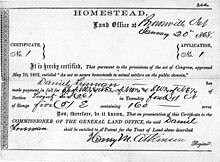A homestead act is one of three United States federal laws that gave an applicant freehold title to an area called a “homestead” – typically 160 acres (65 hectares or one-fourth section) of undeveloped federal land west of the Mississippi River. 
The original homestead act, known as the Homestead Act of 1862, was signed into law by President Abraham Lincoln on May 20, 1862.[1][2][3][4][5][6] The law required three steps: file an application, improve the land, and file for deed of title. Anyone who had never taken up arms against the U.S. government, including freed slaves, could file an application to claim a federal land grant. The occupant also had to be 21 or older, had to live on the land for five years and show evidence of having made improvements.
Because much of the prime low-lying alluvial land along rivers had been homesteaded by the turn of the twentieth century, a major update called the Enlarged Homestead Act was passed in 1909. It targeted land suitable for dryland farming, increasing the number of acres to 320.[7] In 1916, the Stock-Raising Homestead Act targeted settlers seeking an 640 acres (260 ha) of public land for ranching purposes.[7]
Only about 40 percent of the applicants who started the process were able to complete it and obtain title to their homestead land.[8] Eventually 1.6 million homesteads were granted and 270,000,000 acres (420,000 sq mi) of federal land were privatized between 1862 and 1934, a total of 10% of all lands in the United States.[9] Homesteading was discontinued in 1976, except in Alaska, where it continued until 1986.
